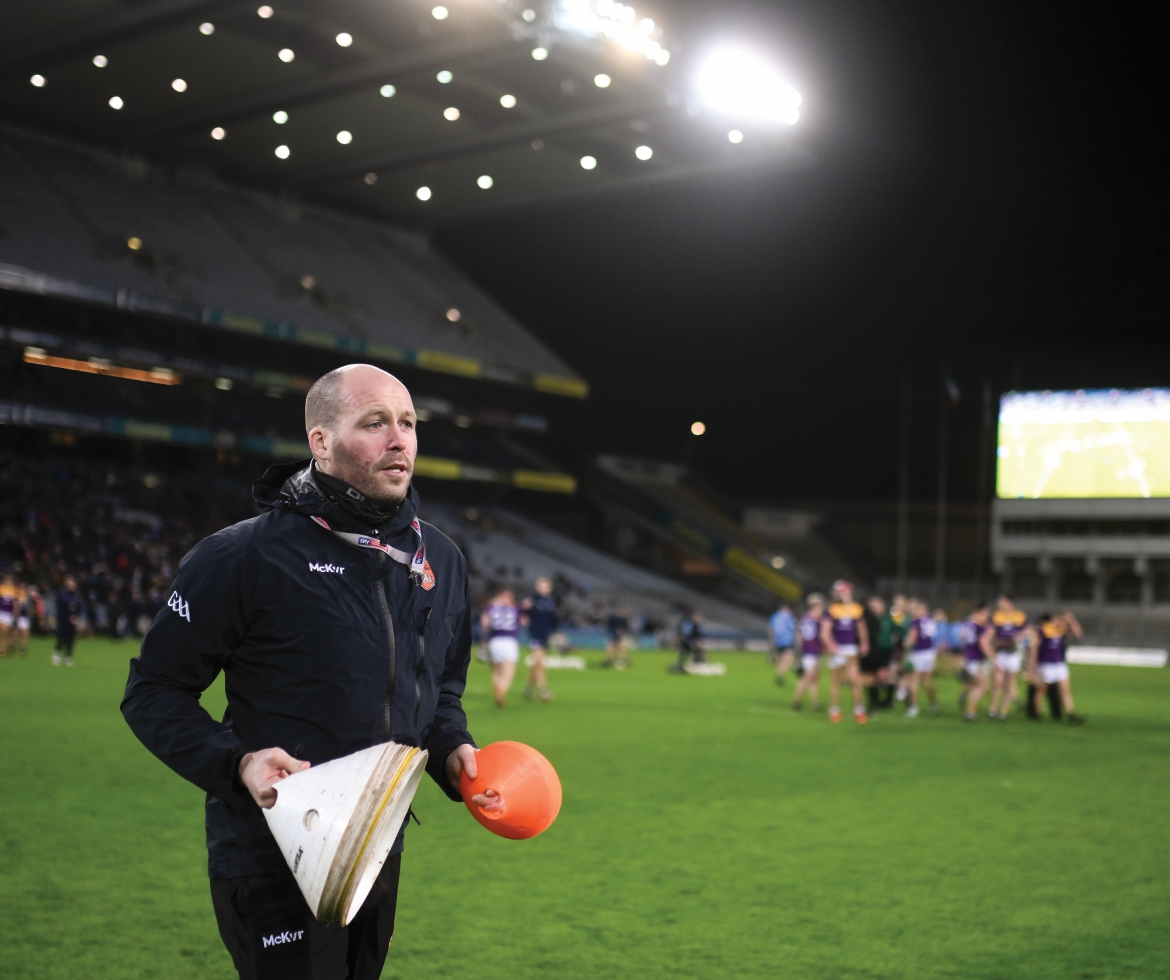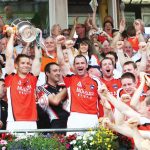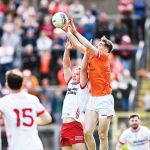Former Armagh captain and All-Ireland winning coach Ciarán McKeever has developed a three versus three game for enjoyment and development. He outlined his concept to Michael McMullan
PLAYERS love scoring goals. That feeling when the ball hits the net sends a surge of energy through the body.
Ciarán McKeever recognises it in the kids he coaches. The adrenaline rush of finding the net can’t be bettered.
At underage, development is one thing but it must come hand in hand with enjoyment. That’s the crux of the new three on three game he has been trialling over the last three years.
It began in primary schools before being rolled into second level. It doesn’t replace what is already there. It is just an addition and something with a bigger picture.
Looking around at packed pitches, there wasn’t enough room for young players to fully express themselves.
It was time to look at options and he liked what three on three concept offered to soccer across the water in England.
“I put my own rules and conditions to it before converting it into Gaelic games,” McKeever said.
In GAA, there were variations of small-sided games. Three versus three was different.
“The dimensions of the pitch are 20 metres wide by 40 in length, so there’s plenty of space for the kids to try things and be able to beat someone one-on-one,” he said.
The stipulation is goals only. It’s not about burling points from the wing. There are fly goalies but goals can’t be floated into an empty net from the other half.
“My thing is kids all love scoring goals, so it’s just trying to base it around that and put the conditions in place for that,” he added.
“You have to create something; you have to beat a man or else create an overlap to get that goal. You can’t score a goal unless you cross the halfway line so you can’t shoot from your half.”
There is a two-touch rule to promote team play and vision. As Kerry’s march to Sam proved, the head-up footballer can open more doors.
Under McKeever’s game, the teams who use all three players to create overlaps will thrive.
There are no sidelines or kick-outs. There are spare balls at the sideline. It’s just tap and go, three years before the FRC brought it into the new-look game. Frees in the defensive half are replaced by the tap and go.
Each team will have two subs, on and off, all the way through a three-minute game. A player fouled in their offensive half will be awarded a penalty.
It’s a game of freedom, of fun, of expression, of movement, of decision-making and, more importantly, it will be raining goals.
“It’s an understanding of just going out there and playing without any restrictions,” McKeever added.
“There’s no real refereeing in it, they referee themselves, manage themselves and we just let them play for wee three-minute stints.”
Another plus is how it facilitates smaller schools to mix with the bigger population centres.
All that is needed five players. A bigger school can enter two teams. And they will all still get playing in their existing school competitions.
At the top end, there are regional competitions for three v three. Mid, north and south Armagh, with teams progressing to an overall all-county final. It gives the small school a chance to pull up a chair at the top table.
More importantly, the concept below it all is something that will, as McKeever hopes, have a long-term benefit when players taking the skills into their older age groups and into senior.
“When I go in coaching in the schools, I set up a number of mini-pitches and that’s where you’re working more on development,” McKeever said.
“You’re just picking three v threes and you rotate to just get them playing.
“They rotate for 40 minutes. At the end of the day, all they want to do is play football rather than listen to me. We try just to develop them through the games.”
From the pilot school initiative three years ago, progression has been about consistency. The only necessity is grass and enough sets of mini goals to keep it ticking along.
Last year, it was rolled out into the 11 second level schools that feed players into Armagh’s underage academies. The feedback there has also been good.
“There’s a huge benefit of it from just deliberate play,” McKeever outlines of one of its seven foundation stones.
“The big thing they kept coming back was deliberate play where kids had the space to beat a man and be creative and take someone on.
“They’re obviously getting more ball contact with their technical skills and just getting better on the ball.
“Then, there are also the fundamental game movements and moments within the games.”
The core skills are central, combined with a constant demand for players to make decisions. Fist or kick. Shoot or pass. Left or right.
“The big thing that’s coming out of it is the kids saying they’re having more fun playing it because they’re scoring goals.
“They’re getting an opportunity to hit the net, as simple as that sounds, but it’s true. They’re getting more enjoyment out of that, so I suppose that’s the big thing.”
The long-term picture is exposing players to an environment of action and fun. It develops skills they can take back into their full sided games.
“They have the fundamentals that are coming out of it which will enhance their football going down the line,” McKeever adds. “There’s no doubt about that. Where that takes them, who knows?”
Going forward as a concept, McKeever has floated the idea to Croke Park’s head of coaching and games Shane Flangan.
There is a hope of taking a group of players to Dublin to test the three v three metrics alongside those of the larger conditioned games. A comparison of heart rates, ball contact time and even the number of decisions taken.
“I think there will be a mass difference in all of that with the three v three,” McKeever surmised.
“It’s just far more intense, it’s a quicker game and kids are making decisions better and getting more ball contact.
“That’s hopefully where I want to try and get it to and to maybe get it recognised as some type of competition somewhere down the line.”
In an era when the FRC are still convening to polish the overall rules for the game, McKeever is ahead of the curve.
When Armagh teams are fighting for Sam Maguire, for Tom Markham and the Anglo Celt Cup, the games will always be 15-a-side.
For McKeever, maybe one of the players to score the winning goal will have the origin traced back to three minutes of taking the right option in a three v three game at the back of a school in Armagh. He’ll have his coaching eye open.
At a glance
Here is a look at the nuts and bolts of what the game entails.
Rules
• Fly goalkeeper
• Two touch
• Tap and go instead of kicked frees, sidelines and restarts
• Goals only
• Can’t score from outside the halfway line
• Five players per squad
• Three v three with rolling subs
• Three-minute games
• Any foul results in a penalty
Important factors
1.Deliberate play – players play with freedom to make decisions but also play with intention.
2.More ball contact – the more possessions each player has, the more technical, tactical and creative decisions they will have.
3.Fundamental game movement and moments – the format’s game movements, such as overlaps and switching of play, increases skill levels.
4.Core skills are active – players are constantly able to practice their skills and develop their decision making.
5.Lots of one v one scenarios – due to the smaller numbers, players have one v one opportunities, but also one v two and one v three.
6.Problem solving – small-sided games are great for setting players game-related problems that they have the freedom to find solutions to.
7.More action, more fun – the games are high intensity, full of goals and joy.
Receive quality journalism wherever you are, on any device. Keep up to date from the comfort of your own home with a digital subscription.
Any time | Any place | Anywhere















